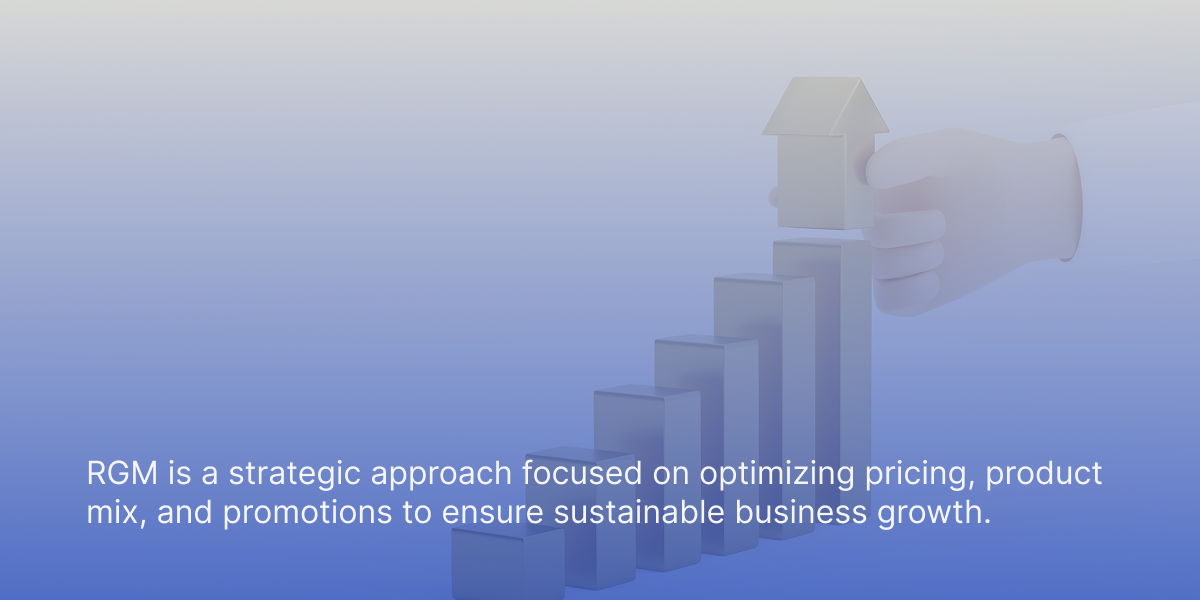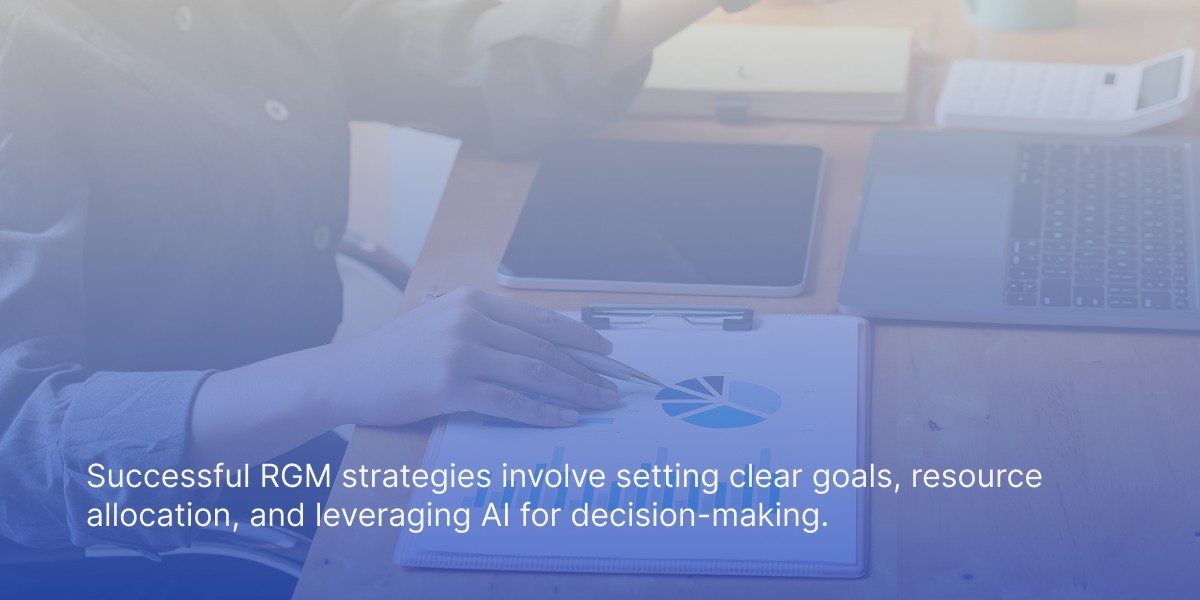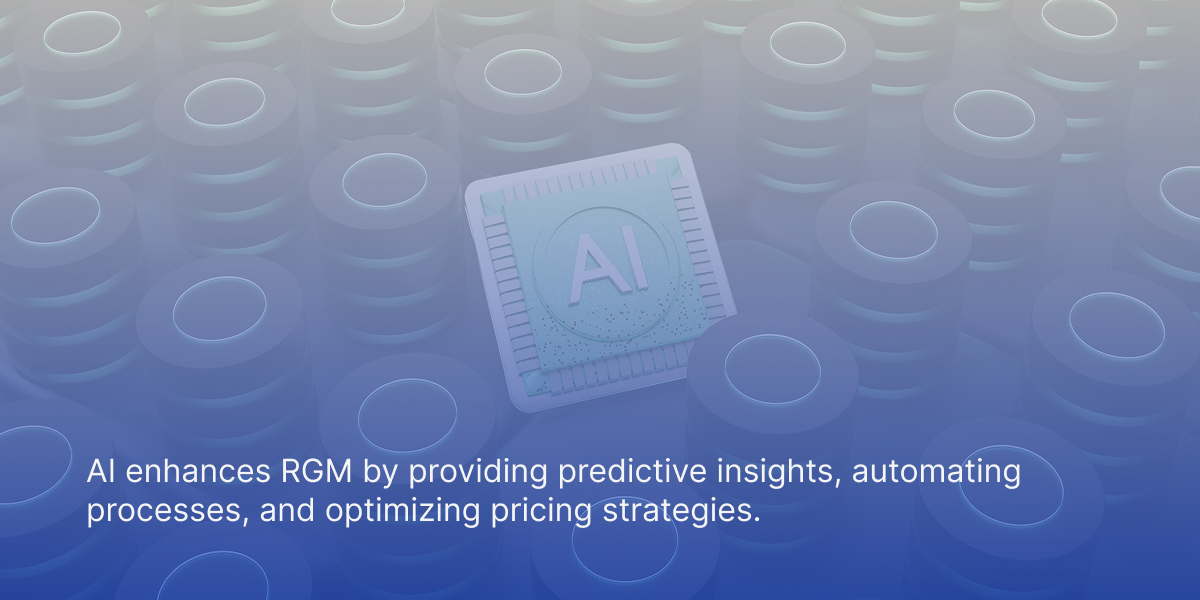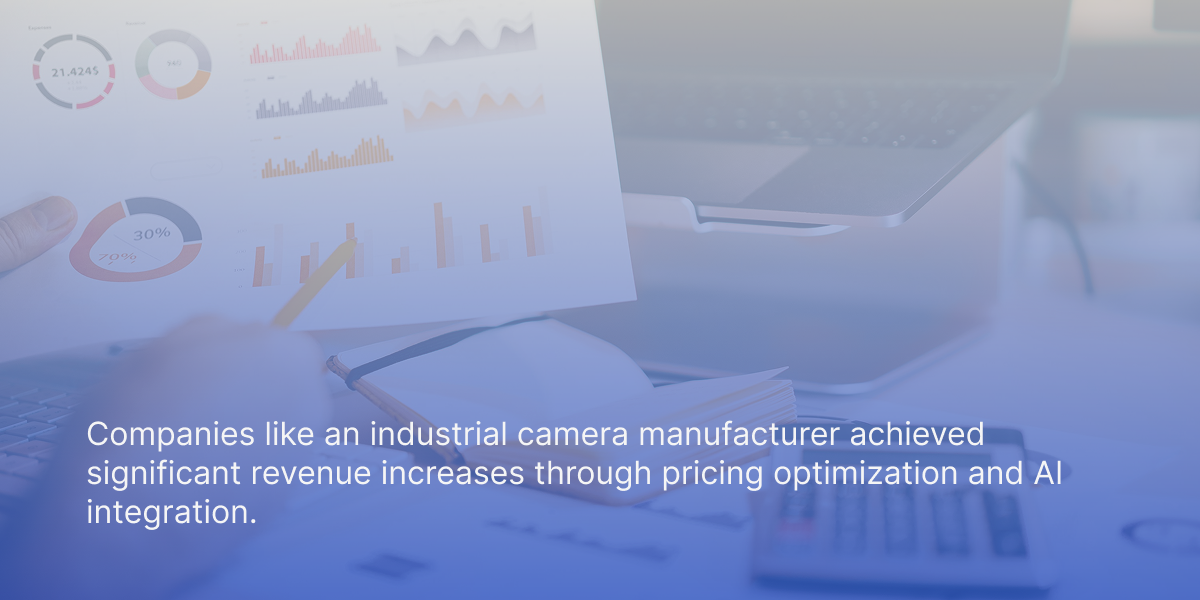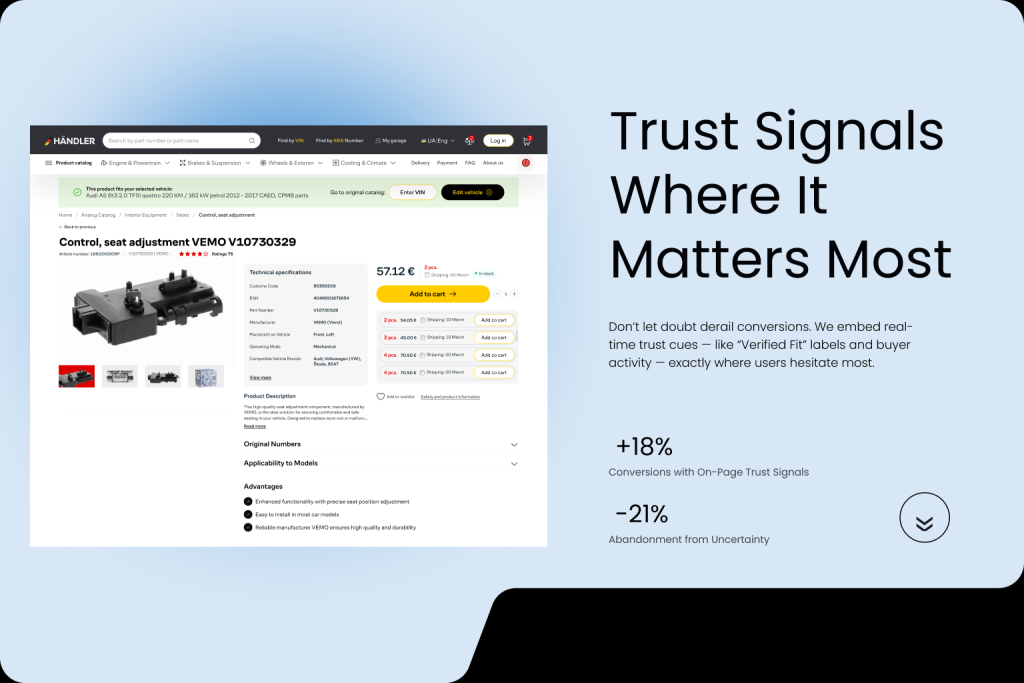Wondering how to boost your business’s revenue? Revenue Growth Management (RGM) could be the key. RGM focuses on optimizing pricing, product mix, and promotions to drive sustainable growth. This article will cover RGM’s basics, advanced tools, and successful case studies.
Key Takeaways
- Revenue Growth Management (RGM) utilizes strategic planning in pricing, product mix, and promotions to achieve sustainable business growth.
- Advanced analytics and AI integration in RGM enhance decision-making, enabling businesses to identify trends, optimize pricing strategies, and improve customer engagement, thereby gaining a competitive advantage.
- Implementing effective RGM strategies requires aligning goals, optimizing resource allocation, and selecting the right RGM software to meet evolving customer needs.
Introduction to Revenue Growth
Revenue growth is a crucial aspect of any business, as it enables companies to expand their operations, increase their market share, and improve their profitability. In the consumer packaged goods (CPG) industry, revenue growth is particularly important, as it allows companies to stay competitive in a rapidly changing market. Effective revenue growth management (RGM) strategies are essential for CPG companies to drive sustainable and profitable growth. By leveraging advanced analytics, data-driven insights, and optimized pricing strategies, companies can enhance their revenue growth and stay ahead of the competition.
In the CPG industry, where market dynamics and consumer preferences are constantly evolving, having a robust revenue growth strategy is vital. Companies must continuously adapt to new trends and demands to maintain their market position. This involves not only understanding the current market landscape but also anticipating future trends and consumer behaviors. By implementing effective RGM strategies, CPG companies can ensure they are well-positioned to capitalize on new opportunities and drive sustainable growth.
Understanding Revenue Growth Management (RGM)
Revenue Growth Management (RGM) is crucial for achieving sustainable business expansion by strategically planning and implementing tactics that secure continuous revenue enhancement. It focuses on refining the four Ps-price, product, placement, and promotion – to fully harness potential revenues, fostering profitable growth. RGM aligns a company’s financial aspects with its performance metrics to facilitate gradual yet consistent expansion.
Initially conceived around 50 years ago, RGM has been embraced across diverse sectors and has progressively integrated cutting-edge tools and technologies. Its evolution from manual approaches to adopting AI-infused instruments enables businesses to make informed decisions swiftly – an essential component in maintaining competitiveness within the dynamic market landscape today.
For optimal demand forecasting and decision-making processes within an organization, precise recognition of revenue is indispensable. By merging pricing strategies with product management as well as distribution channels seamlessly into one framework, RGM improves operational efficiency while encouraging cross-departmental synergy – which not only broadens customer reach but also drives overall corporate growth.
Employing specialized software for Revenue Growth Management helps scrutinize varying pricing models effectively automates numerous financial activities associated with it while delivering valuable insights into various fiscal indicators alongside reported earnings data. A coherent approach carved out through a clear-cut plan equips enterprises with strategic guidance necessary for realizing their revenue objectives. This capability endures beyond initial consultancy engagements when implemented via robust platforms loaded with advanced capabilities designed specifically for Revenue Growth Management solutions – all sustained by overarching net revenue management practices along including considerations such as annual recurring income streams plus comprehensive techniques aimed at optimizing available resources (revenue optimization) and managing total gross income figures – that all together significantly contribute toward driving sustainable revenue growth.
Understanding Consumer Packaged Goods (CPG) Industry
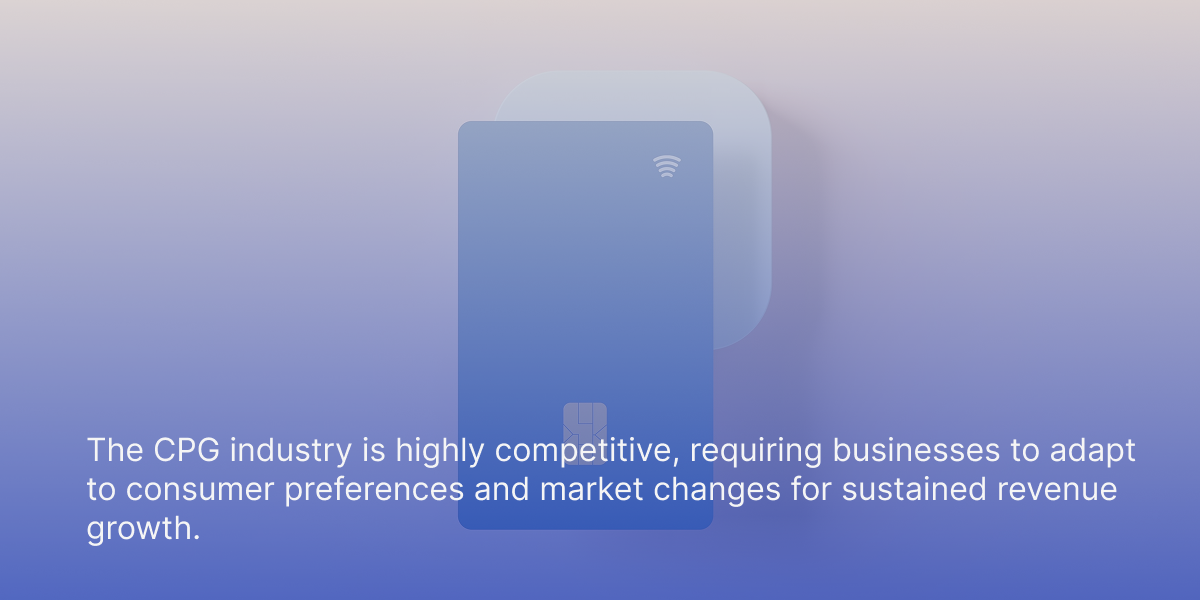
By leveraging data analytics, market research, and demand planning, CPG companies can gain valuable insights into consumer behavior and develop effective strategies to drive revenue growth. Understanding what drives consumer purchasing decisions, how preferences change over time, and what emerging trends are likely to impact the market are all critical components of a successful revenue growth strategy. This comprehensive understanding allows companies to tailor their product offerings, marketing efforts, and distribution strategies to better meet consumer needs and stay ahead of the competition.
Key Components of RGM
Revenue Growth Management (RGM) hinges on a triad of critical elements: strategic pricing, optimization of the product assortment, and management of promotional activities. These factors collectively fuel profitable expansion by integrating multiple facets of business operations to improve both efficiency and decision-making capabilities.
Within this RGM framework, each aspect assumes a pivotal position. Effective pricing strategies, including competitor pricing analysis, are essential for determining optimal price points that not only draw in and keep customers, but also enhance profit margins. The tailoring of the product portfolio ensures it resonates with consumer preferences as well as current market trends. Meanwhile, adept promotion management orchestrates targeted promotions that amplify sales figures and customer engagement – thereby establishing an all-encompassing approach to RGM.
Pricing Strategies
Implementing a strong pricing strategy that focuses on optimizing profitability is crucial for fostering long-term revenue growth. Such strategies draw from approaches like value-based, competitive-based, and dynamic pricing to modify prices in alignment with market conditions, market demand, and the readiness of consumers to spend. This enables organizations to efficiently manage their revenue streams.
Brands can adapt quickly to changing consumer trends and market demands through dynamic pricing strategies. For instance, an enterprise specializing in industrial cameras experienced a marked increase in revenues after adopting a value-based pricing approach. In another case, by transitioning from cost-plus to channel-specific pricing models, a battery manufacturer significantly improved its profit margins. These cases underscore the necessity of tailoring one’s price tactics according to shifting customer tastes and marketplace requirements.
By employing artificial intelligence (AI) and machine learning technologies within their pricing frameworks, businesses are able not only optimize these structures, but also better attract new customers while retaining existing ones, thus boosting their customer acquisition efforts. The careful analysis of evolving consumer preferences empowers companies to adjust their offerings suitably to current market needs – thereby heightening profitability as well as spurring onward overall revenue development.
Product Mix Optimization
Utilizing data to select products enables the identification of customer preferences and nascent market trends across various consumer segments. Managing product portfolios ensures alignment with consumer demands, giving precedence to items poised for substantial growth. By heeding customer input and modifying product offerings accordingly, companies can devise robust revenue growth strategies that spur innovation.
Revenue Growth Management (RGM) propels innovation through insights critical for crafting new products and services aimed at fulfilling unaddressed consumer desires. A cpg company can leverage these innovations in both its offerings and service delivery to address these gaps, thus solidifying its presence in the market while catalyzing profitable expansion that bolsters overall business efficacy – a pivotal consideration for any cpg firms vying for a lead in the competitive realm of consumer packaged goods.
Optimizing a blend of products is instrumental in ramping up sales volume alongside profitability margins. Positioning high-potential items strategically within one’s inventory assortment, thereby tailoring it more closely to what customers are seeking out, both magnifies portfolio value as well as refines supply chain operations. This calculated method not only positions enterprises on top of prevailing market trends, but also ensures they fulfill evolving client expectations effectively.
Promotion Management
Strategic promotions boost sales and consumer engagement by creating purchase incentives and enhancing customer loyalty. Effectively managed promotions increase sales, enhance engagement, and improve overall business performance by aligning with pricing and distribution strategies.
Promotions drive sustainable revenue growth by creating purchase incentives. Increased consumer engagement leads to higher sales volumes and improved business performance. Aligning promotions with business strategies ensures long-term revenue growth and profitability.
In today’s competitive market, effective promotion management is crucial for staying ahead. Strategic promotions aligned with pricing and distribution strategies drive revenue growth and enhance profitability, boosting sales and improving business performance and customer engagement.
Advanced Analytics in RGM
Advanced analytics in Revenue Growth Management (RGM) provide data-driven insights that enhance decision-making and profitability. Data analysis and forecasting, leveraging historical data, are crucial for understanding performance and anticipating market trends. AI-driven tools convert complex data into understandable insights, facilitating quicker decision-making.
AI and machine learning in RGM enhance sales efforts and improve customer engagement. Utilizing advanced analytics helps companies identify hidden revenue opportunities, underperforming products, and high-potential customer segments. This comprehensive analysis informs inventory and financial forecasting decisions.
Generative AI enhances scenario planning by simulating various pricing strategies based on historical and market data. This enables dynamic price adjustments, enhancing profitability. Integrating CRM and revenue management software aids in tracking revenue and automating processes, resulting in more effective revenue growth management.
Implementing Effective RGM Strategies
The execution of successful Revenue Growth Management (RGM) tactics comprises numerous essential retention strategies. Establishing well-defined targets for the revenue growth management strategy and synchronizing these with the company’s overarching goals directs focus toward fostering sustainable and profitable growth via revenue growth management methods.
Resource distribution in RGM permits companies to pinpoint opportunities to bolster profits and dispense resources efficiently. Classifying initiatives by their practicality and potential influence helps in managing expansion proficiently. Centering on high-potential projects streamlines resource use, which propels revenue advancement.
Artificial Intelligence considerably boosts the deployment of an RGM strategy. It consolidates various sets of consumer information, generating all-encompassing profiles that underpin informed decision-making processes. AI facilitates a shift from elementary pricing approaches to sophisticated, automated schemes. This enhances market adaptability while contributing positively to business performance overall.
Conducting assessments about team roles within RGM ensures alignment with enterprise objectives. Extensive training programs including applied analytics instruction utilizing platforms such as R or Python for crafting predictive models are vital. Committing investment towards education guarantees that teams tasked with implementing Revenue Growth Management possess requisite competencies enabling them to carry out efficient strategies effectively.
Distribution Strategies for CPG Companies
Effective distribution strategies are critical for CPG companies to ensure that their products reach consumers efficiently and effectively. By optimizing their distribution networks, companies can reduce costs, improve product availability, and enhance customer satisfaction. CPG companies must consider factors such as supply chain management, logistics, and retail partnerships when developing their distribution strategies.
Leveraging data-driven insights and advanced analytics can help companies identify opportunities to improve their distribution networks and drive revenue growth. For instance, analyzing sales data and consumer purchasing patterns can reveal areas where distribution can be optimized to better meet demand. Additionally, strong retail partnerships can enhance product visibility and availability, further driving sales and revenue growth. By continuously refining their distribution strategies, CPG companies can ensure they are delivering their products to consumers in the most efficient and effective manner possible.
Financial Operations and Revenue Growth
Financial operations play a vital role in driving revenue growth for CPG companies. By optimizing their financial operations, companies can improve their profitability, reduce costs, and enhance their competitiveness. CPG companies must consider factors such as revenue recognition, financial forecasting, and resource allocation when developing their financial strategies.
Leveraging advanced analytics and data-driven insights can help companies identify opportunities to improve their financial operations and drive revenue growth. For example, accurate revenue recognition ensures that companies have a clear understanding of their financial performance, while effective financial forecasting allows them to anticipate future revenue streams and allocate resources accordingly. By continuously monitoring and optimizing their financial operations, CPG companies can ensure they are well-positioned to achieve their revenue growth objectives.
The Role of AI in Modern RGM
Artificial Intelligence bolsters Revenue Growth Management (RGM) by employing predictive analytics to project future trends and customer actions, as well as predictive analytics to provide strategic advice. This dual approach equips companies with the knowledge necessary for making decisions that propel sustainable revenue growth.
The integration of AI into RGM amplifies its dynamism, automates processes, quickens operations, improves precision, expands capability and delivers informed insights. An RGM system powered by artificial intelligence upgrades decision-making capabilities through instantaneous understanding of consumer behavior and tastes.
Capitalizing on Artificial Intelligence allows organizations to fine-tune their RGM tactics, which leads to enhanced outcomes in terms of both performance metrics and financial gain by improving key capabilities in aligning sales reps with effective pricing strategies and tailored messaging for specific sales channels.
Common KPIs in Revenue Growth
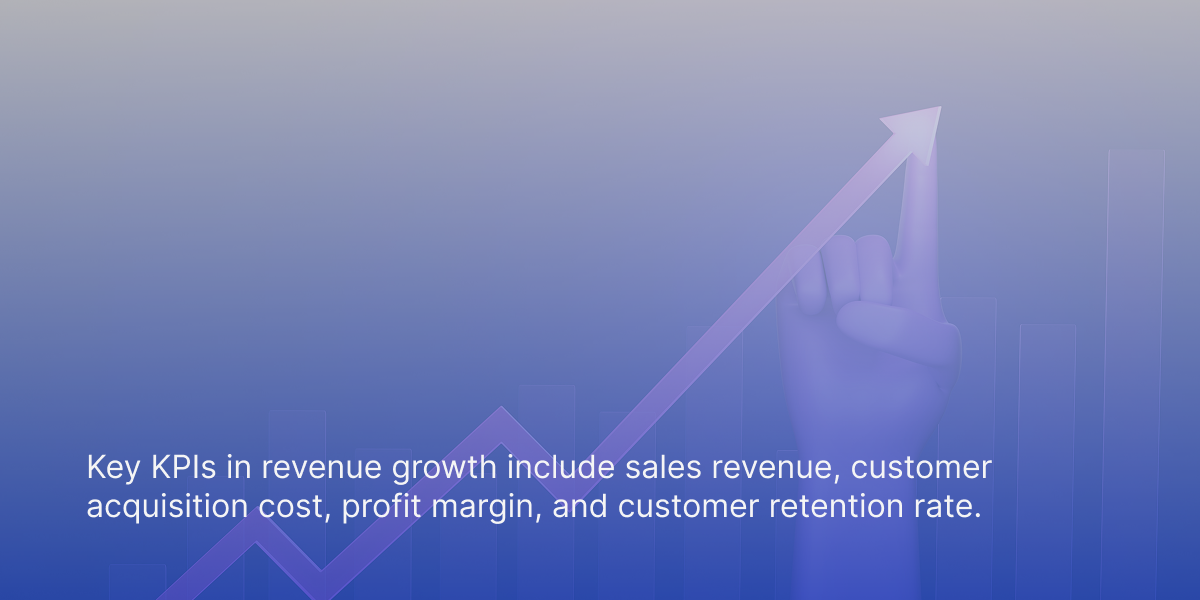
By leveraging data analytics and advanced analytics, companies can track their KPIs and make data-driven decisions to drive revenue growth. For instance, understanding price elasticity can help companies optimize their pricing strategies to maximize revenue, while tracking customer retention rates can provide insights into the effectiveness of their customer engagement efforts. By continuously monitoring and analyzing these KPIs, CPG companies can ensure they are on track to achieve their revenue growth objectives and make any necessary adjustments to their strategies.
Benefits of Strong RGM Practices
Robust Revenue Growth Management (RGM) strategies markedly boost profitability through the optimization of trade spending returns, leading to profitable revenue growth. Firms that implement thorough RGM programs may witness an increase in their annual trade expenditure yields ranging from 2% to 5%, a principal advantage of proficient RGM implementation.
Successful RGM approaches elevate market presence by setting companies apart in crowded industries. Embracing RGM leads to improved partnerships with retailers, which bolsters promotional efforts and optimizes product positioning on shelves.
By improving the efficiency of supply chains, businesses can cut expenses and enhance their capacity to fulfill customer needs effectively.
Overcoming Challenges in RGM
Challenges often accompany the adoption of Revenue Growth Management (RGM) strategies. A prevalent issue is a lack of uniformity in trade planning due to disparate revenue management systems being used by different teams. Addressing this problem involves standardizing RGM efforts and fostering robust communication among teams.
Focusing too narrowly on categories poised for high growth can potentially erode cash flow and diminish value for shareholders. To prevent this, organizations should adopt an equitable approach to RGM that takes into account all aspects of the business. Maintaining volume control and improving supply chain efficiency are critical measures for protecting profits amidst uncertain conditions.
Success in omnichannel retail hinges on devising promotional strategies that are both innovative and flexible enough to cater to varied consumer demands. Employing advanced analytics coupled with artificial intelligence supports crafting promotional tactics designed not only to spur revenue growth but also boost overall profitability. Navigating obstacles effectively requires persistent enhancement and creativity within RGM initiatives, driving sustainable growth and laying the groundwork for enduring success in meeting these challenges.
Choosing the Right RGM Solution
Selecting an appropriate revenue growth management platform is essential for the success of strategic efforts. Aligning product offerings with consumer preferences and demands in the market through RGM software platform enhancement ensures optimized products. Such integrations serve to minimize obstacles and augment the value obtained from a customer over time.
Assessment of RGM solutions should prioritize their efficiency in amalgamating data pertaining to various facets of revenue generation. An effective RGM system empowers businesses to anticipate and adapt swiftly to changing consumer requirements, securing opportunities for increased revenues while preserving competitiveness within the marketplace.
Critical considerations when reviewing potential RGM systems include their proficiency in refining product assortments, compatibility with pre-existing technological frameworks, and ability to yield actionable intelligence that informs decision-making processes. Opting for a suitable RGV solution underpins not only successful ventures, but also enables sustained development of crucial proficiencies conducive to profitable expansion.
Case Studies of Successful RGM Implementation
Case studies of effective Revenue Growth Management (RGM) strategies offer instructive examples. An industrial camera company in North America embraced pricing optimization tactics, which led to a substantial rise in revenue – a 79% surge for its core segment and 21% expansion within the enterprise segment.
These outcomes underscore the primary advantages of proficient RGM methods. By utilizing insights derived from data and employing sophisticated analytics, firms are able to refine their pricing approaches, advance their product propositions, and bolster promotional activities – securing an edge over competitors.
Such instances serve as evidence that RGM is instrumental in fostering sustainable and profitable growth, underlining its critical role within contemporary business paradigms. These case studies highlight the importance of revenue growth management capabilities, which leverage advanced analytics and AI/ML tools to optimize sales channels, track key performance metrics, and tailor strategies to enhance conversions across different consumer segments.
Summary
To summarize, a revenue growth management solution serves as a robust approach that empowers companies to fine-tune their pricing structures, product assortment, and promotional tactics in pursuit of enduring and lucrative expansion. Utilizing sophisticated analytics and artificial intelligence tools enables organizations to extract critical insights regarding consumer patterns, emerging market trends, and opportunities for increasing revenue. When RGM is implemented effectively, it can significantly bolster profit margins, amplify market presence, and foster greater collaboration with retail partners.
It’s essential for enterprises striving to remain at the forefront of an ever-evolving marketplace to invest in solid RGM strategies alongside appropriate technological solutions. By navigating obstacles creatively and persistently innovating within the realm of RGM practices. Firms can safeguard the success of their initiatives focused on revenue growth management. The current landscape presents a timely opportunity for businesses ready to adopt such methodologies so as to realize their maximum potential earnings.



